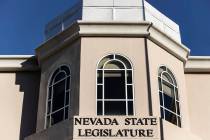Earmark? Yes, but it’s our earmark
Depending on your point of view, earmarks are either evidence that a congressman is working hard for his home state or a gaudy earring dangling lower each year due to a sagging lobe.
In Nevada's Legislature, earmarks are generally applied to things most other states willingly fund with surplus revenue -- mental health hospitals, schools for the deaf or advanced medical care facilities.
In Congress, earmarks covering everything from bridges "to nowhere" to support for mariachi bands have drawn the ire of fiscal conservatives.
And in most cases the criticism is rightly earned. The logic behind spending $200 million on a bridge from Anchorage to a rural port with one tenant can't be justified even in Alaska.
But here in Nevada, a little "charity" case is a good example of why abolishing all earmarks in Congress is the wrong way to fiscal reform.
In truth, Congress has proved unwilling to apply common sense when making decisions about how to distribute funds. And the only way to truly keep ridiculous projects from getting federal money is to eliminate earmarks altogether.
But it hardly seems fair to change the dirty system now that Nevada is finally in position to play along. With Senate Majority Leader Harry Reid's hands on every bill in Congress and Reps. Shelley Berkley and Jon Porter serving on the House Appropriations Committee, Nevada has never been in a better position to finally wield a little well-earned clout.
The latest focus of pork bashing is right here in West Las Vegas, where one of the nation's biggest athletic givers has brought a ray of hope to the state's broken education system. A $200,000 earmark for the Andre Agassi College Preparatory Academy won notice in the conservative blogosphere as another unnecessary spending request.
Rep. John Campbell, R-Calif., announced he was going to work to strip the funding, which Berkley added to a spending bill.
"I don't think it is appropriate to use hardworking taxpayer funds to make a donation to charity, particularly one so closely connected to one of the richest young people in America," Campbell told Steve Tetreault of the Stephens Media Washington bureau. "If this entity needs another $200,000, I would think Mr. Agassi could probably spare that more than the taxpayers."
Agassi, who won eight major singles titles in men's tennis and an Olympic gold medal, amassed plenty of money over his two decades in the game and has also spread that wealth famously on behalf of at-risk children in Southern Nevada.
It's his devotion to that issue that led him to found the Agassi Boys and Girls Club and raise $60 million for more than 20 local causes over the years.
Last year Berkley requested $175,000 for the charter school, an earmark that never made it out.
The Agassi Foundation borrowed funds to build the $40 million school and is the guarantor of the debt.
And here's why the school is an island of success in a state that underfunds its students: Agassi writes the check each year to make sure the students are funded at about $9,000 apiece, personally adding to the $5,200 the state provides for each of the 540 boys and girls.
The extra $3,800 per kid helps with supplies, technology and classroom materials. It also brings the kids in his school up to the national funding average, while the rest of Nevada's schools make do with some of the worst financial support in the nation.
So what's wrong with supporting a proven success? Is it because the children largely come from the adjacent downtrodden area? Or is it because Mr. Agassi, in addition to being one of the greatest tennis players of the open era and a heck of a philanthropist in his own right, is a Democrat?
Campbell is a part of the Republican Study Committee, a group of fiscal conservatives who spotlight a variety of local projects as wasteful spending. In addition to the Agassi funding, Campbell's group went after a program for underprivileged children in Alaska, drawing the ire of Republican Don Young (of Bridge to Nowhere fame).
But Young isn't the only critic of attempts to eliminate all earmarks. Porter, who is continuing to move to the left after his close election win last year, supports the Agassi funding and says each project should be judged on its own merits.
The Agassi school has become successful, in part, because it has a longer school day and a considerably longer school year.
It's a model the federal government should support precisely because it has been successful.
This is not a start-up looking for capital construction costs. It's a school that's used partnerships (federal, state and private money) to create a good learning environment.
And as long as Congress is still playing the earmark game, there's nothing wrong with funding for the Agassi school. And perhaps its continued success will help spark more philanthropic spending on education here to satisfy the gaping needs.
Erin Neff's column runs Sunday, Tuesday and Thursday. She can be reached at (702) 387-2906, or by e-mail at eneff@reviewjournal.com.
ERIN NEFFMORE COLUMNS























